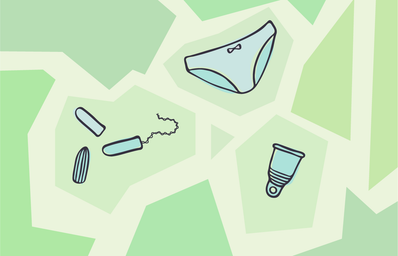This past summer, I decided to make a massive change in how I viewed and treated my monthly cycle. For almost a decade, like many Americans who bleed, I relied on tampons and maxi pads. I did not think twice about it because the women in my life and the limited sex education I had, taught me that this was the normal, reasonable option – I never had a reason to second guess it. For the most part, while my period was not pleasant (I don’t think any uterus owner’s is) it was simple. However, after some health concerns of my own that led to experimenting with my birth control dosage and trying to navigate debilitating cramps and other symptoms, I realized I had to start making active choices.
The first part of my journey was changing my mindset. I wanted to think of my choices as a part of my overall self-care. Often we are taught about our periods as “something to deal with,” and we lose sight of the fact that this is a part of our healthcare. Adopting the perspective of making decisions that are best for my health also made me question what decisions are best for the long term.
I was inspired to write this article by a TikTok uproar that had taken place against L. Organic Tampons, after a user reported that the brand used titanium dioxide in their product, which caused her to bleed for two weeks. She developed ovarian cysts, underwent testing for ovarian cancer, and had fertility screenings. After doing research, I learned that titanium dioxide is used to organically bleach menstrual products. The United States FDA allows the chemical to be present in many forms of our daily life (coffee creamer, toothpaste, salad dressings, sunscreen, etc.) but is regulated to small doses. That being said, the EU (European Union) has banned the chemical from food items as research shows that inhaling the chemical is toxic. Additionally, many doctors recommend limiting our contact with the chemical. As those of us with uteruses know, we must be cautious with what comes in contact with the lower parts of our bodies. Why would we allow a carcinogenic chemical in our underwear?
I was also drawn to changing my routine from the standpoint of sustainability. On average, a uterus owner will have 456 periods in their life, using approximately 9,120 tampons. At an average price of seven dollars for a box of 36 tampons, the total amount women spend on tampons is approximately $1,773.33. Moreover, each tampon is sold with a plastic applicator and takes a minimum of six months to decompose. Meanwhile, maxi pads take 500-800 years to decompose. As someone who stopped eating meat for environmental reasons, I could not digest these facts and knowingly contribute to creating that much waste.
So you may be wondering, out of all the options, why menstrual cups? I first decided that I did not want to use anything that was made of cloth. While the most sustainable option, the laundry aspect hindered my ability to commit to that. I share a washer and dryer with others, so I cannot always do laundry immediately – and a period product is not something you want to hold off on washing. This left me with deciding between a cup or a disc. Knowing my own anatomy, I felt starting with a cup would be best, plus I wanted the extra security that the tails cups have. Therefore, I do not have any reason to not promote a menstrual disc aside from my own inexperience (I have heard that these allow people to have mess-free sex, so that may be a bonus to some!). Plus, I loved that one cup could last ten years if properly taken care of.
I started with the popular diva cup – while it did its job and I was very happy with the overall experience, I personally needed a more flexible silicone. I switched to Ruby the following month and do not have a single complaint. The silicone is more flexible, making the cup easy to manipulate, the tail is longer and can be cut to the desired length, and the cup is black, so it will not stain. I love that the cup only has to be changed 2-3 times a day and is completely leakproof. I usually change it when I wake up and an hour or so before bed. The cup cannot be felt during the day, I have actually forgotten that I was on my period with it in, and it has made my cramps more bearable. Lastly, the cup cleans very easily with just hot water and is sterilized at the beginning and end of every period.
Some advice I would give to anyone interested in trying a menstrual cup is as follows. First, get comfortable with being uncomfortable. The cup itself will not hurt you if used properly, but the process is more involved. Periods are stigmatized, and unfortunately, the default is feeling embarrassed. You will need to become familiar and comfortable with your anatomy. It takes time to get used to, but it is so worth it. Second, watch tons of videos! Not only on how to insert the cup in many different ways but on reviews to help you find the cup best for you. Lastly, I promise the cup is never actually “stuck,” but it is easy to be frustrated or scared when this concern arises. Take a second to collect yourself, reposition your body, and breathe through it. Realistically this does not happen often and should not be a major concern.
Before ending this article, I want to recognize the privileges I had in making this decision. I do not face the harms of period poverty. I have bodily autonomy, and I live in a place, and have the economic means, where I have unlimited access to reproductive healthcare. These privileges have allowed me to make informed decisions based only on my personal preferences and not outside factors. In recognizing this, I wanted to make sure I made a choice that also aided other people – I invested in the Ruby cup because each purchase includes a donation of a menstrual cup for a person in need. I highly recommend this company if you are interested in trying out a menstrual cup. (Side note: This article and I have no affiliation with the company. I just really do love having it as a part of my routine and supporting their cause.)
The menstrual cup is not for everyone, but you can always try. Further, the change does not have to be all or nothing. I still carry tampons in my purse in case my period ever starts early. I hope the biggest takeaway from reading my journey is the inspiration to become in tune with your cycle and treat your decisions as part of your healthcare. Every person who bleeds deserves to make active, autonomous decisions for their body.


